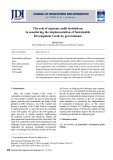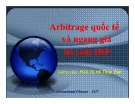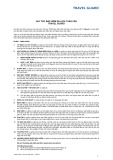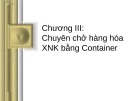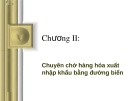
http://www.iaeme.com/IJM/index.asp 202 editor@iaeme.com
International Journal of Management (IJM)
Volume 8, Issue 1, January–February 2017, pp.202–211, Article ID: IJM_08_01_024
Available online at
http://www.iaeme.com/ijm/issues.asp?JType=IJM&VType=8&IType=1
Journal Impact Factor (2016): 8.1920 (Calculated by GISI) www.jifactor.com
ISSN Print: 0976-6502 and ISSN Online: 0976-6510
© IAEME Publication
COMPARISON OF METHODS FOR THE
RECOGNITION OF DERIVATIVE FINANCIAL
PRODUCTS WITHIN THE SCOPE OF TURKISH
FINANCIAL REPORTING STANDARDS (TFRS)
Burak TERİM, Ph.D
Asst. Professor
Manisa Celal Bayar University
Faculty of Economics and Administrative Sciences
Department of Business Administration, Manisa/Turkey
ABSTRACT
In the global competition environment, the companies’ areas of usage regarding derivative
financial products became widespread and these instruments started to take an important place in
the liability statements of the businesses. In terms of financial accounting, the companies need to
reflect the usage of derivative financial products in their financial statements, and in terms of
administrative accounting, they search for methods that will facilitate the follow-ups for the
performance assessment and decision making procedures regarding the processes of large scale
derivatives.
The companies making investments in the derivatives in hopes of risk management or speculation
acquire mutual rights and liabilities through the contracts they make. For the assessment and
recognition of these rights and liabilities, the standards numbered TMS 32, TMS 39, TFRS 7 and
TFRS 9 were published by the Public Oversight Authority of Turkey. These standards coincide with
the standards published by the International Accounting Standards Board (IASB).
In this study, attention is drawn to the assessment and recognition of the derivatives in line with
the aforementioned standards, and alternative solutions are discussed.
Key words: Derivatives, Hedge Accounting, IAS 32, IAS 39
Cite this Article: Burak TERİM, Comparison of Methods For The Recognition of Derivative
Financial Products Within The Scope of Turkish Financial Reporting Standards (TFRS),
International Journal of Management, 8(1), 2017, pp. 202–211.
http://www.iaeme.com/ijm/issues.asp?JType=IJM&VType=8&IType=1
1. INTRODUCTION
In terms of provisions and sales, the companies currently continuing their operations sustain their relations
with the outer world in their production and sales operations, with the capacity of importer and/or exporter.
Additionally, they supply their financial needs not only from internal sources (national banks, national
money), but also from external financial sources (foreign banks, foreign leasing companies).

Comparison of Methods For The Recognition of Derivative Financial Products Within The Scope of Turkish
Financial Reporting Standards (TFRS)
http://www.iaeme.com/IJM/index.asp 203 editor@iaeme.com
As a result of this, the companies have the capacity to determine the hedge prices (fixing the late charges
or foreign exchange rates) in accordance with the sectors and market types in which they carry out their
operations. However, while the competition in the markets usually makes the practices of price hedging
difficult, it also increases financial risks.
Just like the investors, it can be said that the total risk encountered by the businesses during their
operating periods is the total systematic and non-systematic risks, depending upon the uncertainty.
Systematic risk factors can be market risks, political risks, interest rate risks and foreign exchange rate risks.
These risk types concern the economy in whole, and comprise the risks that the business administration
cannot intervene.
Nonsystematic risks can be defined as financial risks, management risks, industrial risks and operations
risks; and these risks are usually encountered by the businesses due to their own characteristics. The business
administration can intervene in these kinds of risks (Sayılgan, 2003, p.340).
The businesses usually prefer the usage of derivatives while diversifying the liability factors for
optimizing the systematic and non-systematic risks.
In this study, the aim is to discuss an alternative approach concerning the recognition of the financial
transactions made by the businesses according to TMS 32 and TMS 39, in order for the businesses to be
protected from various risks.
2. DERIVATIVE FINANCIAL INSTRUMENTS AND HEDGING
Derivatives have been used for years as an effective risk management (hedging) instrument. When the
Bretton Woods system (fixed exchange rate system) ended in 1972, the fluctuations in the exchange rates
caused the companies to face exchange rate risks. On the other hand, fluctuations in the exchange rates in
international money markets brought up the issue of high interests to the agenda. As a result of these
developments, the derivative instruments, which were implemented only for commercial goods before,
started to be used with the intent of prevention from the aforementioned risks (Kaygusuzoğlu, 2011, p.138).
The fast development of the derivative financial instruments and the widespread usage of the derivative
instruments in businesses brought up the recognition of these to the agenda. Recognition of the derivative
financial instruments and demonstration of the relevant risks accurately in the financial statements and their
disclosure has been set out in the accounting standards and financial reporting standards by the International
Accounting Standards Board. Also in Turkey, the Turkish Accounting Standards Board published the
standards regarding the derivative financial instruments in parallel with the international accounting
standards. These standards are as follows:
• TMS 32 “Financial Instruments: Presentation”
• TMS 39 “Financial Instruments: Recognition and Measurement”
• TFRS 7 “Financial Instruments: Disclosures”
• TFRS 9 “Financial Instruments” (Bal and Öztürk, 2013, p.124-125).
In TMS 32, a financial instrument is defined as “a contract that gives rise to a financial asset of one entity
and a financial liability or equity instrument of another entity”.
The derivative financial instruments can be defined as financial products, which can be assessed in
association with the asset prices, foreign currency, interests or stock market. The concerned products are
various, depending upon the types of wares, interest rates, foreign exchange rates, share indices and share
certificates.
Hedging is defined as the methods of protection ensuring that the losses that may be originated from the
fluctuations in the future interests, prices or foreign exchange rates are maintained minimum (Uzun, 2004,
p. 10). The companies’ objective is to be protected from the damages incurred due to price movements by
hedging the risks in order not to undergo the unexpected developments in foreign exchange rates, interest
rates, stock quotes and asset prices.

Burak TERİM
http://www.iaeme.com/IJM/index.asp 204 editor@iaeme.com
Derivatives can be used to transfer the risk from the parties wanting to be protected from the risks to the
parties wanting to undertake the risks, and they can also be used for profits (Kaygusuz, 1998, p.11, Uzun,
2004, p.10).
Derivatives are described in TFRS 9 Financial Instruments Standard as follows:
Derivative: A financial instrument or other contract within the scope of this TFRS (see paragraph 2.1) with
all three of the following characteristics.
• (a) Its value changes in response to the change in a specified interest rate, financial instrument price,
commodity price, foreign exchange rate, index of prices or rates, credit rating or credit index, or other variable,
provided in the case of a non-financial variable that the variable is not specific to a party to the contract
(sometimes called the ‘underlying’).
• (b) It requires no initial net investment or an initial net investment that is smaller than would be required for
other types of contracts that would be expected to have a similar response to changes in market factors.
• (c) It is settled at a future date.
Derivatives can be used in organized markets and over-the-counter markets. Organized markets are the
markets buying and selling standard derivatives in line with legal arrangements. All other transactions made
outside of these markets can be referred as transactions in over-the-counter markets.
Derivatives are used to decrease the cost of the used capital and to furnish these instruments with
incentive characteristics for the investors, by bringing up the financial instruments that can keep up with the
changes in the financial markets. In addition, derivatives can also be used with the intention of protecting
the businesses form the future risks, which may occur in the stock exchange values, interest rates and foreign
exchange rates. The main intended usages of derivatives are as follows (Ocakoğlu, 2013, p.53):
• To reduce the debt costs,
• To increase the debt capacity,
• To increase the net cash flows,
• To protect the existing assets and liabilities from risks,
• To protect the foreign currency commitments from risk,
• To protect the net investments of the associated companies.
In addition to the main intended usages regarding the derivatives, the usages with the intent of speculation
and arbitrage should also be addressed (Dizman, 2014, p.21);
• Speculation: Based on the estimations and expectations, speculation is the act of buying or selling an asset
with the intent of generating a profit from the increases and decreases of the asset's price. For the estimation
to be successful, it is necessary to possess more information than the others and to be able to evaluate this
information better.
• Arbitrage: Arbitrage is the purchase of an asset at a lower price than the market, and selling the asset at a
higher price in another market.
The main derivatives are: forward contracts, futures contracts, options and swaps. Brief definitions of these
contracts are given below:
Forward contracts are used in over-the-counter (off-exchange) trades. A forward contract is a contract
between the parties to buy or sell a specific number of commercial products or financial instruments at a
specified price on a specific future deat. These contracts generally cannot be transferred or exchanged, and
it can be terminated with the parties’ mutual agreement. The price of the forward cannot be updated in line
with the market value. Therefore, since the profits or losses cannot be known before the settlement date,
there can also be no cash flow during this time. The profits and losses appear at the settlement date
(Kaygusuzoğlu, 2011, p.141).

Comparison of Methods For The Recognition of Derivative Financial Products Within The Scope of Turkish
Financial Reporting Standards (TFRS)
http://www.iaeme.com/IJM/index.asp 205 editor@iaeme.com
Forward contacts can generally be used for all kinds of goods. In accordance with its general usage in
the markets, frequently encountered forward contract types are foreign exchange forward contracts, interest
forward contracts and commercial goods/commodity forward contracts.
Futures contracts have the same intentions and functions as the forward contracts. The main difference
between them is that the futures contracts are standardized and used in organized markets. A futures contract
is a contract of a standard time period and amount, which is used in organized stock market and based on
the daily settlement procedures (Chambers, 2012, p.6). Although there is no commitment liability in forward
contracts, there is a liability to fulfill the daily commitments in futures contracts. In addition, while the true
market value cannot be determined in forward contracts, it is possible to determine the daily market price in
futures contracts (Ocakoğlu, 2013, p. 51).
Options, which can be defined as “right to choose” in line with its lexical meaning, are financial
instruments newer than the forward and futures contracts.
An option also represents a contract including the future delivery of a property or financial asset at a
price agreed upon today. However, its functioning is different than forward and futures contracts. The option
contract offers the right to buy or sell a property or a financial asset in a specific period of time and at an
agreed-upon price. The option holder has the right to use, or not to use the option in the exercise date in
exchange for a certain premium. The option holder is not obliged to use the option at the exercise date. The
maximum loss of the option buyer is the premium s/he pays. In return, the option seller receives the premium;
however, the party buying the option has the right to use or not to use the option. In return for the premium
received, the option seller acts in accordance with the decision of the option buyer (Adıgüzel and Yılmaz,
2015, p.18).
A swap is a contract through which two companies exchange future cash flows. The most frequently
used derivative contracts in global markets are the swaps. Even though it is not used in official markets in
Turkey, swaps are the leading contracts used frequently by the banks and companies in their interest risk
management processes. A swap is a contract through which two parties exchange future cash flows. While
one of the parties makes fixed payment, the other chooses a payment plan based on a certain variable and an
index price. Within the framework of their payment plans made in accordance with the swap contract, the
parties exchange a cash flow. Each party has different expectations regarding the price received in the future
period by the underlying asset which will be exchanged. In swaps, the underlying asset is usually the interest
payment. However, there are also swaps that use foreign exchange rates and commodity products as
underlying assets (Saltoğlu, 2014, p.92).
Most swaps involve foreign exchange swaps and interest rate swaps. A foreign exchange swap is a
contract that consists of swapping two different currencies or the liabilities arising from the different
currencies on the date of the contract, along with an agreement on swapping them again at a later date.
In an interest rate swap, the independent parties, who borrowed the same amount of capital with a similar
settlement date from a different borrowing source, exchange their interest payment liabilities, usually
through an intermediary bank (Dizman, 2014, p.21).
3. HEDGE ACCOUNTING
Hedge accounting is a method of accounting where the derivatives are used for the purpose of protection
from the risk (Haftacı, Pehlivanlı, 2007, p.141). Hedge accounting eliminates or significantly reduces a
measurement or recognition inconsistency (sometimes referred to as ‘an accounting mismatch’) that would
otherwise arise from measuring assets or liabilities or recognizing the gains and losses on them on different
bases (TMSK, notification regarding tms39 S. No: 41, p.3).
The purpose of its accounting policy is to reflect, as much as possible, the aim of the recognized
transaction and its economic effects (Parlakkaya, 2003, p.168, Haftacı, Pehlivanlı, 2007, p. 141).
Within the scope of the standard “TMS 39 Financial Instruments” it is stated that Hedge accounting
recognizes the offsetting effects on profit or loss of changes in the fair values of the hedging instrument and

Burak TERİM
http://www.iaeme.com/IJM/index.asp 206 editor@iaeme.com
the hedged item. In the same standard, hedging relationships are divided into three types: These are as
follows:
• Fair value hedge: A hedge of the exposure to changes in fair value of a recognized asset or liability or an
unrecognized firm commitment, or an identified portion of such an asset, liability or firm commitment, that is
attributable to a particular risk and could affect profit or loss.
• Cash flow hedge: A hedge of the exposure to variability in cash flows that (i) is attributable to a particular risk
associated with a recognized asset or liability (such as all or some future interest payments on variable rate
debt) or a highly probable forecast transaction and (ii) could affect profit or loss.
• Hedge of a net investment in a foreign operation: As defined in TMS 21.
Moreover, in TMS 39, it is stated that a hedge of the foreign currency risk of a firm commitment may be
accounted for as a fair value hedge or as a cash flow hedge.
Using the hedge accounting ensures that the gain or loss on the hedging instrument and the hedged item
are documented in the financial statements of the same periods. When a company becomes a party of a
derivative instrument contract, the company can optionally use the hedge accounting to document the gains
and losses it receives from derivative instruments and the gains and losses concerning the risk it faces.
Currently, within the framework of the decisions of the Public Oversight, Accounting and Auditing
Standards Authority (KGK) in Turkey, the companies’ accounting records are kept in accordance with
TMS/TFRS and TDHP. However, to reflect the profit/loss emerged due to use of derivative instruments in
the financial statement of the period of the relevant profit/loss, it is important for businesses to recognize
such activities according to TMS, and to prepare their financial statements in line with TFRS (Çakır ve
Sabuncu, 2016, p.136).
4. HEDGE ACCOUNTING PRACTICES
Up to the present, in many practices regarding the recognition of derivatives, the transactions regarding the
derivatives have been kept in memorandum accounts, because these derivatives create conditional rights and
liabilities.
The globalization of financial markets and developments in communication technology has increased
the importance of the needs regarding the comparability and transparency of financial statements. Especially
the transparency of the financial statements is very important for all parties associated with the businesses.
Therefore, the businesses’ all kinds of commercial transactions imposing obligations and providing rights to
the business must be shown clearly in the financial statements. Because, when this company goes public, is
transferred or becomes partners with a business, the concerned party should be able to acquire all information
of the company from the company’s financial statements (Kırlıoğlu ve Altınkaynak, 2016, p. 608).
Furthermore, memorandum accounts are the accounts acting as a reminder for the businesses, with their
areas of usage such as the tracking of the letters of guarantee, of sureties and warranties, of the cases filed
that can result in favor/against and that can impose a compensation liability, and of fixed assets, machines,
equipment, tools, materials etc., which are brought outside of the company. Since the transactions kept in
the memorandum accounts do not reflect an asset, resource or income/expense, these accounts cannot be
compared with an asset, resource or operating account (Sevilengül, 2014, p. 610).
At the end of the period, the memorandum accounts must be controlled one by one. If there is no
remaining condition requiring the usage of the memorandum accounts, these accounts should be closed. If
it is determined at the end of the period that these accounts should be further used, no changes in the
memorandum items must be made. For this reason, the accounting units do not carry out the relevant controls
regarding the state of the memorandum accounts, which is a wrong act in practice.
Kırlıoğlu and Altınkaynak used a company operating in agricultural markets and addressed forward
contracts. Emphasizing that the companies need to be transparent in their financial statements, they have
reached the following opinion:

